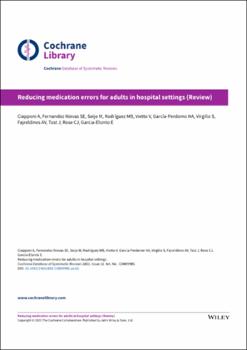Reducing medication errors for adults in hospital settings

View/
Date
2021-11Author
Fajreldines, Ana.
Ciapponi, Agustín.
Fernandez, Simon.
Et al.
Metadata
Show full item recordAbstract
Abstract
Background: Medication errors are preventable events that may cause or lead to inappropriate medication use or patient harm while the medication is in the control of the healthcare professional or patient. Medication errors in hospitalised adults may cause harm, additional costs, and even death.
Objectives: To determine the effectiveness of interventions to reduce medication errors in adults in hospital settings.
Search methods: We searched CENTRAL, MEDLINE, Embase, five other databases and two trials registers on 16 January 2020. SELECTION CRITERIA: We included randomised controlled trials (RCTs) and interrupted time series (ITS) studies investigating interventions aimed at reducing medication errors in hospitalised adults, compared with usual care or other interventions. Outcome measures included adverse drug events (ADEs), potential ADEs, preventable ADEs, medication errors, mortality, morbidity, length of stay, quality of life and identified/solved discrepancies. We included any hospital setting, such as inpatient care units, outpatient care settings, and accident and emergency departments.
Data collection and analysis: We followed the standard methodological procedures expected by Cochrane and the Effective Practice and Organisation of Care (EPOC) Group. Where necessary, we extracted and reanalysed ITS study data using piecewise linear regression, corrected for autocorrelation and seasonality, where possible. MAIN RESULTS: We included 65 studies: 51 RCTs and 14 ITS studies, involving 110,875 participants. About half of trials gave rise to 'some concerns' for risk of bias during the randomisation process and one-third lacked blinding of outcome assessment. Most ITS studies presented low risk of bias. Most studies came from high-income countries or high-resource settings. Medication reconciliation -the process of comparing a patient's medication orders to the medications that the patient has been taking- was the most common type of intervention studied. Electronic prescribing systems, barcoding for correct administering of medications, organisational changes, feedback on medication errors, education of professionals and improved medication dispensing systems were other interventions studied. Medication reconciliation Low-certainty evidence suggests that medication reconciliation (MR) versus no-MR may reduce medication errors (odds ratio [OR] 0.55, 95% confidence interval (CI) 0.17 to 1.74; 3 studies; n=379). Compared to no-MR, MR probably reduces ADEs (OR 0.38, 95%CI 0.18 to 0.80; 3 studies, n=1336 ; moderate-certainty evidence), but has little to no effect on length of stay (mean difference (MD) -0.30 days, 95%CI -1.93 to 1.33 days; 3 studies, n=527) and quality of life (MD -1.51, 95%CI -10.04 to 7.02; 1 study, n=131). Low-certainty evidence suggests that, compared to MR by other professionals, MR by pharmacists may reduce medication errors (OR 0.21, 95%CI 0.09 to 0.48; 8 studies, n=2648) and may increase ADEs (OR 1.34, 95%CI 0.73 to 2.44; 3 studies, n=2873). Compared to MR by other professionals, MR by pharmacists may have little to no effect on length of stay (MD -0.25, 95%CI -1.05 to 0.56; 6 studies, 3983). Moderate-certainty evidence shows that this intervention probably has little to no effect on mortality during hospitalisation (risk ratio (RR) 0.99, 95%CI 0.57 to 1.7; 2 studies, n=1000), and on readmissions at one month (RR 0.93, 95%CI 0.76 to 1.14; 2 studies, n=997); and low-certainty evidence suggests that the intervention may have little to no effect on quality of life (MD 0.00, 95%CI -14.09 to 14.09; 1 study, n=724). Low-certainty evidence suggests that database-assisted MR conducted by pharmacists, versus unassisted MR conducted by pharmacists, may reduce potential ADEs (OR 0.26, 95%CI 0.10 to 0.64; 2 studies, n=3326), and may have no effect on length of stay (MD 1.00, 95%CI -0.17 to 2.17; 1 study, n=311). Low-certainty evidence suggests that MR performed by trained pharmacist technicians, versus pharmacists, may have little to no difference on length of stay (MD -0.30, 95%CI -2.12 to 1.52; 1 study, n=183). However, the CI is compatible with important beneficial and detrimental effects. Low-certainty evidence suggests that MR before admission may increase the identification of discrepancies compared with MR after admission (MD 1.27, 95%CI 0.46 to 2.08; 1 study, n=307). However, the CI is compatible with important beneficial and detrimental effects. Moderate-certainty evidence shows that multimodal interventions probably increase discrepancy resolutions compared to usual care (RR 2.14, 95%CI 1.81 to 2.53; 1 study, n=487). Computerised physician order entry (CPOE)/clinical decision support systems (CDSS) Moderate-certainty evidence shows that CPOE/CDSS probably reduce medication errors compared to paper-based systems (OR 0.74, 95%CI 0.31 to 1.79; 2 studies, n=88). Moderate-certainty evidence shows that, compared with standard CPOE/CDSS, improved CPOE/CDSS probably reduce medication errors (OR 0.85, 95%CI 0.74 to 0.97; 2 studies, n=630). Low-certainty evidence suggests that prioritised alerts provided by CPOE/CDSS may prevent ADEs compared to non-prioritised (inconsequential) alerts (MD 1.98, 95%CI 1.65 to 2.31; 1 study; participant numbers unavailable). Barcode identification of participants/medications Low-certainty evidence suggests that barcoding may reduce medication errors (OR 0.69, 95%CI 0.59 to 0.79; 2 studies, n=50,545). Reduced working hours Low-certainty evidence suggests that reduced working hours may reduce serious medication errors (RR 0.83, 95%CI 0.63 to 1.09; 1 study, n=634). However, the CI is compatible with important beneficial and detrimental effects. Feedback on prescribing errors Low-certainty evidence suggests that feedback on prescribing errors may reduce medication errors (OR 0.47, 95%CI 0.33 to 0.67; 4 studies, n=384). Dispensing system Low-certainty evidence suggests that dispensing systems in surgical wards may reduce medication errors (OR 0.61, 95%CI 0.47 to 0.79; 2 studies, n=1775).
Authors' conclusions: Low- to moderate-certainty evidence suggests that, compared to usual care, medication reconciliation, CPOE/CDSS, barcoding, feedback and dispensing systems in surgical wards may reduce medication errors and ADEs. However, the results are imprecise for some outcomes related to medication reconciliation and CPOE/CDSS. The evidence for other interventions is very uncertain. Powered and methodologically sound studies are needed to address the identified evidence gaps. Innovative, synergistic strategies -including those that involve patients- should also be evaluated.
Copyright © 2021 The Cochrane Collaboration. Published by John Wiley & Sons, Ltd.
Collections
The following license files are associated with this item:

